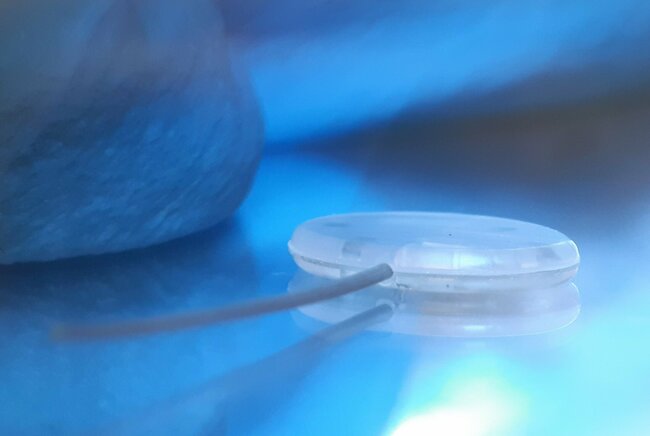Minimally invasive smart glaucoma implants
Inês Figueiredo Pereira received her doctorate cum laude from the department of Mechanical Engineering on July 5th.

Glaucoma, an eye disease that can cause irreversible blindness, is a major health concern worldwide. It is caused by a build-up of fluid in the eye, which leads to increased pressure inside the eye. This pressure can in turn damage the optic nerve, and thus lead to blindness. Pressure can be lowered with eyedrops or laser treatment, but often surgery is needed to drain fluid and lower pressure more effectively. Nonetheless, complications can arise afterwards. For her PhD research, Inês Figueiredo Pereira developed innovative minimally invasive and smart glaucoma implants that have the potential to decrease the incidence of postoperative complications.
Glaucoma is a disease that can lead to permanent loss of vision if left untreated or if it is diagnosed too late, with approximately 80 million people worldwide suffering from the condition. While it can affect people of all ages, it typically affects adults older than 70 years old.
The condition is mainly caused by increased intraocular pressure (IOP) due to an accumulation of fluid inside the anterior chamber, which is located in the front of the eye. This pressure can be lowered with eyedrops or laser treatment, but surgery remains the most effective form of treatment to drain excess fluid from the eye. However, complications are frequent, such as scarring or hypotony, where the intraocular pressure becomes too low.

“Surgery might be the most effective way to handle glaucoma, but the possible complications make it a risky course of treatment,” says Inês Figueiredo Pereira, PhD researcher from the Microsystems group in the department of Mechanical Engineering. “Therefore, a treatment that is minimally invasive can decrease the chances of postoperative complications, and improve the outcomes of surgery.”
Need for improved implants
To begin her journey, Figueiredo Pereira set out to get a better idea of the current implant options out there. “Along with my colleagues, we surveyed the devices available in the market right now to treat glaucoma. Our main finding was that complications with current implants arise because they don’t allow for postsurgical control of IOP.”
In fact, these implants provide a fixed resistance to fluid outflow from the eye, which concerns Figueiredo Pereira. “This is insuficient given that postoperative IOP is always evolving, so an implant that cannot adjust fluid drainage to maintain an healthy IOP in the eye is only going to lead to more issues down the line for the patient.”
The magnetic option
For her research, Figueiredo Pereira next performed numerical simulations to investigate the feasibility of using a glaucoma implant with an adjustable hydrodynamic resistance to regulate IOP in glaucoma patients. “Results from the simulations provided valuable insights that allowed for the development of a magnetically actuated glaucoma implant that can be non-invasively and repeatedly adjusted to different IOP conditions even after implantation,” notes Figueiredo Pereira.
Adjustment is achieved by integrating a magnetic microvalve in the implant, which can open or close fluidic channels, and thus change the hydrodynamic resistance of the implant when needed, and all by using a simple external magnet. “With this valving system, the IOP can be tuned according to a patient’s needs,” says Figueiredo Pereira.

The biodegradable option
Next to the magnetically actuated glaucoma drainage device, Figueiredo Pereira also developed a new biodegradable and minimally invasive glaucoma implant, which is approximately the same size as the world’s smallest medical device known to be implanted in the human body, which is the iStent Inject W from the company Glaukos. “The implant from Glaukos is a permanent and metallic implant, whereas ours is inspired by their implant but it is based on a polymer material (polycarbonate-bisamide or PC-BA) making it biodegradable’, remarks the researcher.
“We anticipate that our implant will slowly degrade and then be absorbed by the body over time, leaving behind a natural pathway for fluid drainage,” says Figueiredo Pereira. “This biodegradable glaucoma implant provides a promising new approach for restoring outflow in a more natural way.”
Critically though, the device develoed by Figueiredo Pereira and her collaborators is even more minimally invasive than devices like the iStent Inject W. “It can be placed at a location in the eye with far less tissue dissection required, all while still fulfilling the main purpose of removing excess fluid from the eye and decreasing intraocular pressure,” notes Figueiredo Pereira.
Exciting potential
The magnetic-based and biodegradable polymer-based implants developed as part of Figueiredo Pereira’s research have the potential to be safer and more effective when it comes to reducing IOP than current devices on the market. In addition, the implants can halt the progression of glaucoma and related visual field loss, and enhancing the quality of life of glaucoma patients.
“I am optimistic that these implants could change the lives of many millions of people. Of course, it will take some time to properly evaluate the devices as further studies are needed to confirm that the implants do not lead to scarring after the implant is removed or vanishes,” says Figueiredo Pereira. “I’m excited to see where things might go with this research.”
Title of PhD thesis: Minimally invasive smart glaucoma implants. Supervisors: Jaap den Toonder, Henny Beckers, and Hans Wyss.
Media contact
Latest news


